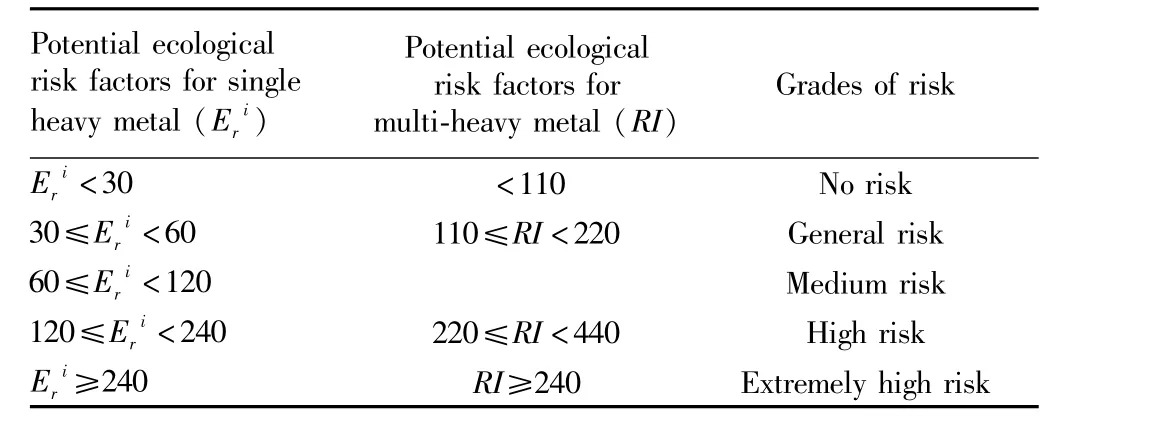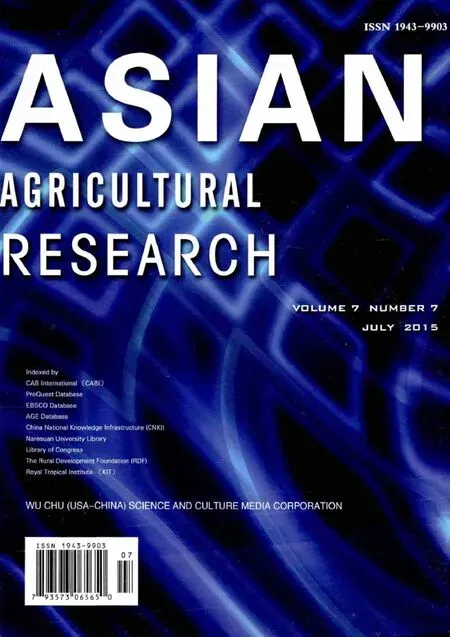Survey and Evaluation of Heavy Metal Pollution in Paddy Soil in West Guangxi
Yuyi HUANG,Guifen CHEN,Liumei XIONG,Yuning WANG,Kaifu YE,Lan ZHANG,Qizhan TANG,Jin WANG
1.Agricultural Resource and Environment Research Institute,Guangxi Academy of Agricultural Sciences,Nanning530007,China;2.Agricultural Information Research Institute,Guangxi Academy of Agricultural Sciences,Nanning 530007,China;3.Guangxi Center of Analysis and Test Research,Nanning530022,China
1 Introduction
With the deteriorating industrial and urban pollution and increasing types and amount of agricultural chemicals,the soil heavy metal pollution is becoming increasingly serious.The area of arable land contaminated by heavymetals has reached more than 20 million ha in China,accounting for20%of totalarable land area;about 12 million t of food is contaminated by heavy metals each year,and the directeconomic losses aremore than 20 billion yuan(Wang Chen,2010).When the heavymetal in soil is accumulated to a certain extent,itwill seriously affect the quality of agricultural products,and it is transmitted into the body of animals and humans through the food chain,threatening the survival and health of the human.Compared to other land use types,the paddy contaminated by heavy metal is easy to cause health risks.West Guangxi is the nonferrousmetal industry base,and the study of the paddy heavymetal pollution in this region is important for the safety of regional agricultural soil environment and agricultural products.The soil heavy metal pollution incidents happen occasionally in Guangxi,and the heavymetal content of arable land is often impermissibly high(Huang Biyan et al.,2000;Chen Guifen et al.,2004;HuangWenxiao et al.,2006;Ling Naigui,2010).Most of the studies on heavymetal in paddy focus on the influence of soil heavymetal content,bioavailability,soil physical and chemical propertiesand physiological characteristicsof rice on migration of heavymetals in the soil and rice,aswell as the evaluation of farmland heavymetal pollution.The study of Zhai Limei et al.(2009)on the spatial distribution and environmental risk of soil cadmium in Xijiang River basin shows thatwithin the basin,32%of soil samples are severely contaminated by cadmium,and some areas are high cadmium risk areas.For different varieties of rice and soil types,there is a difference in the accumulation of cadmium in rice(Wang Ying et al.,2007).The study of Chen Diyun et al.(2010)on the distribution of heavymetals in paddy soil on the coast of Fujian and potential ecological risks demonstrates that themercury content of 46%of soil samples is above the secondary standard value of National Soil Quality Standards,and the cadmium content of13%of soil samples is above the secondary standard value of National Soil Quality Standards;the mercury and cadmium in farmland soil pose a high ecological risk.Peng Hua et al.(2013)study the paddy soil and rice cadmium contamination in a river-irrigated rice-growing area,and find that there is a significant positive correlation between soil cadmium content and rice cadmium content.Currently,the area,distribution and extent of heavy metal pollution of paddy soil in West Guangxi are not clear,leading to a lack of specific prevention measures.By collecting the paddy soil from major rice producing areas in West Guangxi,we analyze the soil heavy metal content and evaluate the environmental risks and potential ecological risks of heavymetal in soil,in order to provide a scientific basis for the prevention and control of paddy soil pollution by heavy metals in the region.
2 Materials and methods
2.1 Sample collectionIn November 2011,we collected the paddy soil from themajor rice producing areas in Hechi City and Chongzuo City.Soil sampling point is selected on the representa-tive plotwith the area ofmore than 2 ha.Using"X"method,we employ wooden spatula and stainless steel earth drilling tools to randomly collect5 to 7 soil samples,and the sampling depth is 0-20 cm(topsoil).After being thoroughlymixed,we use quateringmethod to leave and take 1 kg of samples.The soil is placed in plastic bags and the field number is recorded.A total of50 soil samples are collected.The soil samples collected are dried in the indoor air and sifted by 20-mesh,60-mesh and 100-mesh nylon sieves after the animaland plant residuesand stones are removed.
2.2 Samp le analysisIn this study,the soil is tested in accordance with themethods stipulated in Soil Testing(NY/T1121-2006),Soil Quality-Lead,Cadmium Determination(GB/T17141-1997),Soil Quality-Total Mercury,Total Arsenic,Total Lead Determination(GB/T22105.2-2008)and Soil Quality-Available Lead,Cadmium Determination(GB/T23739-2009).The soil pH is extracted using 1∶2.5 soil-water ratio and glass electrodemethod;the soil total lead and total cadmium are tested using graphite furnace atomic absorption spectrophotometry;soil total arsenic is tested using atomic fluorescence spectrometry;soil available lead and cadmium are tested using DTPA extraction and atomic absorption spectrometry.
2.3 Soil heavymetal pollution and ecological risk evaluation methodsThe secondary standard(agricultural land standard)in National Soil Environmental Quality Standards(GB156182-1995)is used as the soil quality evaluation standard,and single factor indexmethod is taken as the evaluation method.Piis the heavymetal single factor pollution index(Ci/Si,Ciis themeasured concentration of heavy metal elements;Siis the evaluation criteria for the heavymetal elements).When Pi≤1,it indicates that there is no pollution;when 1<Pi≤2,it indicates that it is slightly polluted;when 2<Pi≤3,it indicates that it ismoderately polluted;when Pi>3,the pollution is heavy.The potential ecological risks of soil heavymetal are evaluated using the potential ecological risk indexmethod developed by Swedish scholar Hakanson.Thismethod not only considers the soil heavymetal content,but also combines the ecological and environmental effects of heavymetalwith toxicology,and it is used internationally(Hakanson,1980).The formula is as follows:
where Cfiis the individual pollution parameter;Cisurfaceis the concentration of heavymetals found in soil;Cinis the soil background reference value(using the background value of cadmium,lead and arsenic in paddy soil in Guangxi).
where Eriis the single-metal potential ecological risk index;RI is themulti-metal potential ecological risk index;Triis the toxic response coefficient of ametal,reflecting the response of heavymetal to water,soil and biological phase.
Using the standardized heavymetal toxicity coefficient developed by Hakanson as evaluation basis,Trivalue of cadmium,lead and arsenic is30,5 and 10,respectively.The evaluation indicators for potential ecological risks and grading criteria for pollution intensity are shown in Table 1.

Table 1 Evaluation indicators and grades of potential ecological risk
3 Results and analysis
3.1 Soil pHSoil pH is one of the main factors affecting the chemical forms of heavy metals in soil and plant bioavailability,and also the parameter of soil environmental quality standard value.For different soil pH values,the soil heavy metal limits are different.When soil pH decreases,the exchangeability of cadmium and lead in soil is increased,thereby increasing bioavailability.The results of this study indicate that the paddy soil pH in West Guangxi is 5.31-7.87(the pH of 26 soil samples<6.50;the pH of 12 soil samples is6.50-7.50;the pH of 12 soil samples>7.50).
3.2 Characteristics of heavy metals in soilThe analysis of paddy topsoil inWestGuangxishows that there is great variation of soil heavymetal content(Table 2).As can be seen from Table2,the coefficients of variation of available cadmium and total cadmium in soil are 142.02%and 139.39%,respectively,larger than the coefficients of variation of available lead,total lead and total arsenic.Compared with National Soil Environmental Quality Standards(GB 156182-1995),the soil samples with cadmium and arsenic contenthigher than secondary soil limit value,account for 54.0%and 2.0%of total samples,respectively,and soil lead content does not exceed the standard.The soil samples with cadmium,lead and arsenic content higher than the background values(cadmium 0.148mg/kg;lead 20.14 mg/kg;arsenic 10.63 mg/kg)account for82.0%,74.0%and 32.0%of total samples,respectively(Ban Ling et al.,1991).
3.3 Soil environmental quality evaluationWith the limit value of soil heavymetal content in the secondary standard of National Soil Environmental Quality Standards(GB156182-1995)as the evaluation standard,we use the single factor pollution index method to evaluate the paddy soil environmental quality in West Guangxi,and the statistical analysis results show that the paddy soil samplesheavily polluted by cadmium inWestGuangxiaccount for 32.0%,the samplesmoderately polluted by cadmium account for 8.0%and the samples slightly polluted by cadmium account for 14.0%;the samplesmoderately polluted by arsenic account for 2.0%,and other soil samples are non-contaminated samples;there is no lead contamination in the soil samples.

Table 2 Characteristics of heavy metal in paddy soil in Guangxi
3.4 Potential ecological risk evaluation of soilAccording to the potential ecological risk index developed by Swedish scholar Hakanson,we take the ratio of average contentof heavymetals in surface paddy soil to the background value ofheavymetals in paddy soil in Guangxi as a benchmark,to evaluate the potential ecological risk index of paddy soil in West Guangxi,and the risk index is shown in Table3.As can be seen from Table 3,for the potential ecological risk index of single heavy metal(Eri),Eriof cadmium reaches190.74(high risk),and Eriof lead and arsenic is less than 30(no risk);for the comprehensive evaluation of multiple heavymetals,the potential ecological risk index(RI)of cadmium,lead and arsenic is206.88(normal risk).

Table3 Potential ecological risk index of heavy metals in paddy soil of Guangxi
4 Conclusions and discussions
4.1 ConclusionsThe paddy soil in West Guangxi is contaminated by cadmium,54.0%of soil samples with cadmium content higher than secondary soil limit value,and 32.0%of soil samples are heavily contaminated by cadmium;soil is slightly or not contaminated by lead and arsenic.Rice can strongly absorb cadmium,and this property will be strongerwith the declining soil pH.
4.2 DiscussionsWest Guangxi is an important non-ferrous metal production base in Southwest China,and it is rich inmineral resources,but the agricultural soil is polluted by heavy metal,which is closely related to themining activities in this area(Zhai Limei etal.,2009).In this study,we use the single factor pollution index and Hakanson's potential ecological risk index to survey the status of heavymetal pollution in paddy soil ofWest Guangxi,and the findings show that the paddy soil inWestGuangxi ismainly affected by cadmium.The results of this study are consistent with the findings of Ling Naigui(2010).By comparing the background value of heavymetal in soil with the background value of heavymetal in the country,the average background value of cadmium is1.75 times higher than the national average(ZhengWu,1993).The background value of cadmium in soil in Guangxi is higher than the national background value of cadmium in soil,whichmay be one of the reasons for the excessively high contentof cadmium in paddy soil in WestGuangxi.The paper does not carry out the studies on heavymetals in rice and the heavymetal pollution threshold of paddy soil,which will affect the comprehensive control over heavy metal pollution in paddy soil.Therefore,we can carry out the above studies in future research.In this study,52%of the soil is acidic or acid soil,sowe should pay enough attention to the rice safety problems caused by cadmium pollution.
[1]BAN L,DING YF.Research method of soil background values and soil background values of Guangxi[M].Nanling:Guangxi Science and Technique Publishing House,1991:122.(in Chinese).
[2]CHEN DY,XIEWB,SONG G,et al.Heavymetal pollution and potential ecological risk of paddyfield soil in littoral area,Fujian Province[J].Chinese Journal of Soil Science,2010,41(1):194-199.(in Chinese).
[3]CHEN GF,HUANGWJ,ZHANG LM,et al.Survey and evaluation of heavy metal contamination of soils and vegetables in Nanning[J].Guangxi Agricultural Sciences,2004,35(5):389-392.(in Chinese).
[4]HUANG BY,WEIYN.Survey and evaluation of heavymetal contamination of soils and agricultural products in Nanning suburban of Guangxi[J].Agro-Environment and Development,2000,17(4):20-21.(in Chinese).
[5]HUANGWX,TENG DJ,NIEWG,et al.Investigation and evaluation on the soil quality of cultivated land in Guangxi[J].Guangxi Agricultural Sciences,2006,37(6):703-706.(in Chinese).
[6]LING NG.Status of heavymetals in different type of farmland soil of Guangxi[J].Ggro-environment and Development,2010(4):91-94.(in Chinese).
[7]PENG H,DAIJP,JIXH,et al.Correlation between cadmium content in paddy soil and in rice[J].Hunan Agricultural Sciences,2013(7):68-72.(in Chinese).
[8]WANG C.Effects of silicon on physiological-biochemical properties and heavymetals uptake of Turfgrass under heavy metals compound pollution[D].Beijing:Beijing Forestry University,2010.(in Chinese).
[9]WANG Y,LIZW,HE ZJ.Difference and dynamics of Cd uptake in four rice cultivars[J].Journal of Guangxi Agricultural and Biological Science,2007,26(8):82-85.(in Chinese).
[10]ZHAILM,LIAO XY,YAN XL,et al.Spatial variation and environment risk of cadmium in agricultural land in the Xijiang River draining of Guangxi Province[J].China Environmental Sciences,2009,29(6):661-667.(in Chinese).
[11]ZHENGW.Study on heavymetal background values of farmland in northeast of Guangxi[J].Rural Ecological Environment,1993(4):41-42.(in Chinese).
[12]HAKANSON L.An ecological risk index for aquatic pollution control:A sedimentological approach[J].Water Research,1980,14(8):975 -1001.
[13]WANG P,ZHAO ZZ,WANG JG,et al.Hazard Assessment on Heavy Metal Pollution in Surface Soil from Tea Gardens ofWuzhishan[J].Agricultural Science&Technology,2011,12(3):426-428,465.
 Asian Agricultural Research2015年7期
Asian Agricultural Research2015年7期
- Asian Agricultural Research的其它文章
- Forecasting of the Egg Price Based on EEMD
- On Modern Fruit Production in Japan
- Study on the Improvement of Performance of Global Supply Chain Based on Quantity Flexibility Revenue Sharing Contract
- Supply Chain Optimized Strategies in the Mode of External Financing
- Financial Support for Rural Cooperative Economy in China Based on Grey Correlation Analysis
- A Study on the Driving Factors of Food Production in Huang-Huai-Hai Plain Based on Path Analysis
